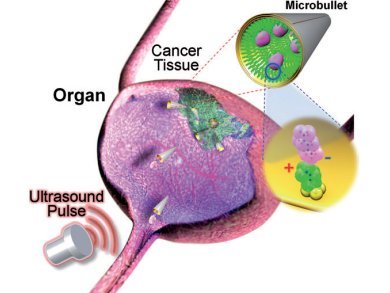Micro- and Nanomachines Powered by Ultrasound
Microscopically small submarines that can swim through our blood to clear out clogged arteries or destroy malignant tumors. This concept may sound utopian, but it isn’t. Various micro- and nanomachines have in fact already been developed. In the journal Angewandte Chemie, American researchers have now introduced a new type of machine that finally has enough propulsive power to penetrate tissue and overcome cellular barriers.
Previous approaches suffered from the fact that the tiny machines didn’t have enough power or lacked biocompatibility. A team led by Sadik Esener and Joseph Wang at the University of California, San Diego, USA, has now overcome this challenge. Their new type of micromachine owes its amazing power to ultrasound, which explosively vaporizes tiny drops of liquid, accelerating the machines like bullets.
Aiming the Microbullets
These novel “microbullets” are conical, pointed, gold-coated tubes with dimensions on the micrometer scale. Their interior is additionally coated with a special biocompatible substance that is capable of binding tiny drops of emulsion through electrostatic interactions. The emulsion used is based on biocompatible perfluorocarbon compounds. An additional magnetic component (nickel) ensures that an external magnetic field can be used to direct the tube to the desired location and orientation.
When ultrasound is then directed at this location, the drops are explosively vaporized. Like bullets in a gun barrel, the tubes are pushed forward by the microexplosion. Depending on the dimensions of the tubes, the size and composition of the emulsion drops, and the strength of the ultrasound signal, speeds around 6.3 m/s can be attained. This is about one hundred times faster than previously reported micromachines, and is enough to shoot the tiny bullets into tissues. Because the fuel is “on board”, propulsion is independent of the environment.
Possible Applications
There are a wide variety of possible applications: microbullets could be used to drive drugs deep into diseased tissue, shoot genes into cell nuclei for gene therapy, scrape deposits off of arterial walls, shoot antitumor drugs directly into a tumor, or even carry out micro-operations.
A first area of application may be local stimulation of the immune system for fighting bladder cancer. In conventional treatment, a weakened form of the bacterium that causes tuberculosis is introduced to the bladder, causing a superficial bladder infection. This activates the immune system, which attacks the tumor cells as well as the tuberculosis bacteria. Instead of this approach, the microbullets could be shot into the bladder wall to initiate the desired inflammatory reaction – without the risks and side effects associated with the bacteria.
Image: © Wiley-VCH
- Acoustic Droplet Vaporization and Propulsion of Perfluorocarbon-Loaded Microbullets for Targeted Tissue Penetration and Deformation,
Daniel Kagan, Michael J. Benchimol, Jonathan C. Claussen, Erdembileg Chuluun-Erdene, Sadik Esener, Joseph Wang,
Angew. Chem. Int. Ed. 2012.
DOI: 10.1002/anie.201201902




